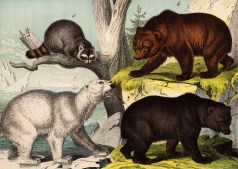The Evolution of Historic Natural Preservation Efforts: A Deep Dive
The preservation of natural landscapes and ecosystems has evolved significantly over the centuries. From early conservationists to modern environmental movements, efforts to protect our planet’s natural heritage have grown in complexity and scope. This article explores the evolution of historic natural preservation efforts, highlighting key milestones, influential figures, and ongoing challenges.
Early Conservation Movements
The roots of preservation can be traced back to the late 19th century, when individuals began recognizing the value of protecting nature from industrialization. Notable figures like John Muir advocated for the establishment of national parks in the United States, with Yosemite National Park being one of the first designated areas in 1890. These early movements focused on preserving scenic beauty and wildlife habitats that were threatened by urban development and logging.
Legislation for Protection
As awareness grew about environmental issues, legislative measures began to take shape in the 20th century. The U.S. National Park Service was established in 1916 to manage national parks and monuments. During this time, several landmark laws were enacted including the Wilderness Act of 1964 which aimed to preserve pristine wilderness areas across America. These laws laid a framework for more organized efforts toward natural preservation.
The Rise of Environmentalism
The latter half of the 20th century saw a surge in environmental activism sparked by events such as Rachel Carson’s ‘Silent Spring’ published in 1962, which highlighted pesticide impacts on ecosystems. The first Earth Day was celebrated in 1970, marking a pivotal moment for grassroots environmental movements worldwide. This period witnessed increased public engagement with nature conservation as well as significant policy changes aimed at protecting air quality, water sources, and endangered species.
Global Initiatives and Agreements
In recent decades, global awareness has prompted international cooperation on preservation efforts through treaties such as the Convention on Biological Diversity established in 1992. Countries across the globe have committed to conserving biodiversity while promoting sustainable use practices that benefit both people and nature alike. These agreements emphasize that local actions contribute to global outcomes regarding climate change and habitat loss.
Modern Challenges and Future Directions
Despite progress made over centuries, historic natural preservation efforts face numerous challenges today including climate change impact, habitat destruction due to urban expansion or agriculture expansion, and loss of biodiversity at an alarming rate. However, innovative approaches such as community-based conservation initiatives and technology-driven monitoring systems are emerging as powerful tools for enhancing these efforts moving forward.
Understanding how historic natural preservation efforts have evolved helps us appreciate our responsibility towards safeguarding our environment today—and inspires future generations to continue these critical endeavors.
This text was generated using a large language model, and select text has been reviewed and moderated for purposes such as readability.


